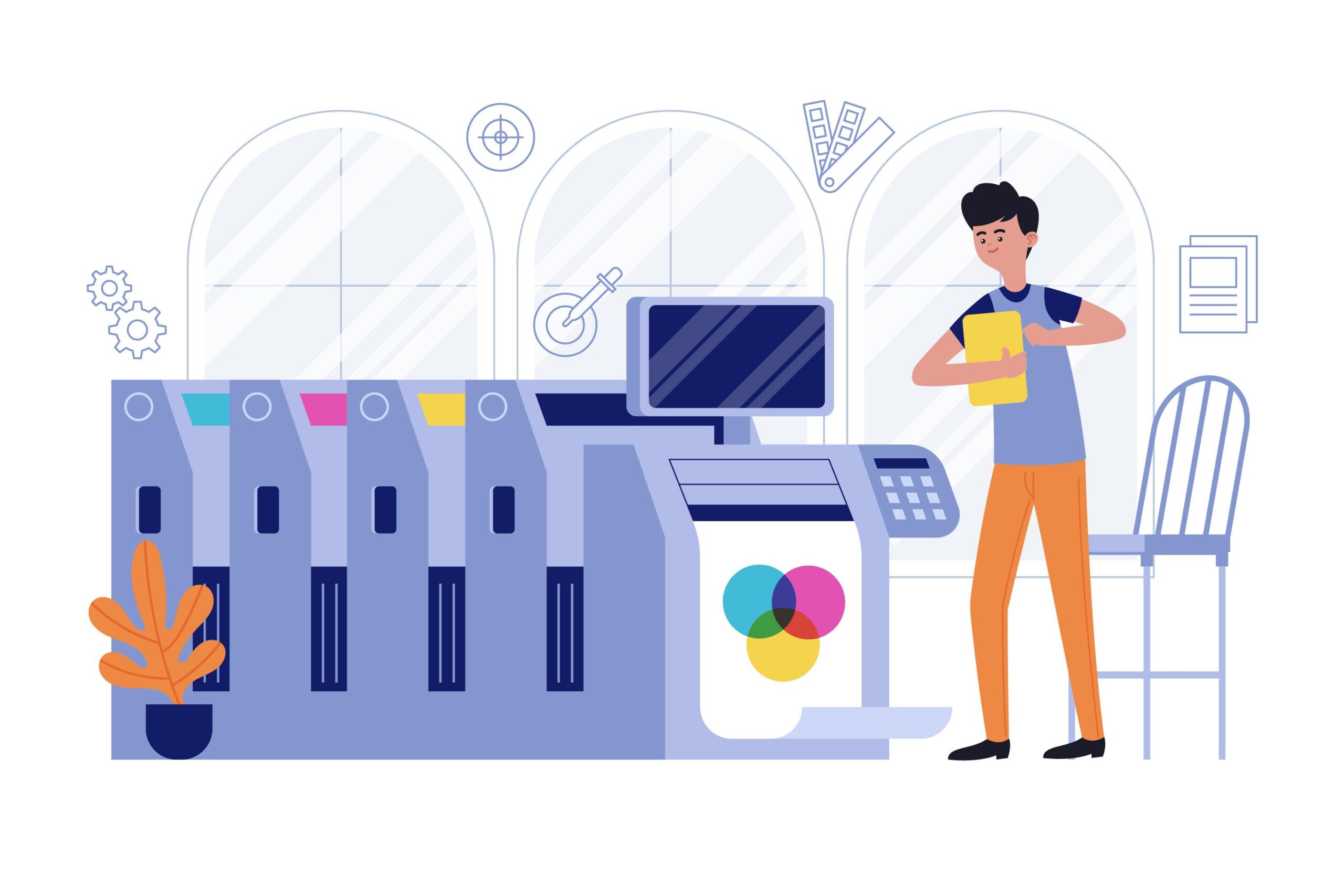Print advertising has long been a cornerstone of marketing strategies, shaping the way businesses communicate with their target audience. In this digital age, where online platforms dominate advertising landscapes, print advertising continues to hold its ground, showcasing its effectiveness through compelling statistics.
The history of print advertising can be traced back to ancient civilizations, where inscriptions and posters were used to promote goods and services. Over the centuries, newspapers, magazines, and billboards emerged as powerful mediums, transforming the way businesses reached their customers.
One of the distinct advantages of print advertising lies in its tangible nature, allowing consumers to physically engage with the content, leaving a lasting impression. Moreover, print materials often enjoy a more focused readership, ensuring targeted messaging to specific demographics. However, print advertising also faces some challenges, such as limited interactivity compared to digital platforms and the necessity for physical distribution.
As we delve deeper into the realm of print advertising, we present 30 unique statistics that shed light on its impact, effectiveness, and enduring relevance in the ever-evolving world of marketing. From consumer preferences to return on investment (ROI), these statistics will provide valuable insights for businesses seeking to optimize their advertising strategies and engage with audiences through the power of print.
Editor’s Choice Statistics
- Newspaper Advertising Dominates with $34.86bn Market Volume in 2023
- Magazines Capture 95% of the Young Audience
- Print Ads: Easier on the Brain, Greater Impact
- Print and Direct Mail Marketing: A 9% Customer Response Rate
- Print Advertising Trumps Digital in Brand Recall
- Direct-Mail Outperforms Email in Response Rate
- Print Advertisements Drive Web Traffic
- 81% of Monthly Newspaper Readers Stay Loyal to Print
- Print Ad Emotional Reaction Increases to 37% in 2020
- Print Ad Spending Decline Projected: $44,173M to $35,628M (2021-2025)
Top 30 Print Advertising Statistics
1. Print Advertising Spending to Reach $48.59bn in 2023
Ad spending in the Print Advertising market is projected to reach an impressive US$48.59 billion in 2023. As businesses recognize the enduring power of print media, investments in newspaper and magazine ads continue to rise. This growth signals the sustained relevance and impact of print advertising in the digital age.
2. Newspaper Advertising Dominates with $34.86bn Market Volume in 2023
In 2023, Newspaper Advertising retains its dominant position in the Print Advertising market, boasting a substantial market volume of US$34.86 billion. Despite the rise of digital media, newspapers remain a trusted source of information, attracting advertisers seeking to engage with a broad and diverse audience.
3. United States Leads Global Print Advertising Spending with $11.34bn in 2023
Among countries, the United States leads the pack in Print Advertising spending, expected to reach a staggering US$11.34 billion in 2023. The country’s robust economy and diverse media landscape make it a prime market for advertisers to reach a broad spectrum of consumers through print channels.
4. Print Advertising’s Reader Base to Grow to 1.38bn Users by 2027
The Print Advertising market anticipates a significant expansion in its reader base, reaching approximately 1.38 billion users by 2027. Despite the digital shift, print media’s enduring appeal and continued reach into various demographics play a pivotal role in sustaining and growing its audience.
5. Average Ad Spending per Reader Reaches $27.13 in Newspaper Advertising
In the Newspaper Advertising market, the average ad spending per reader is projected to reach US$27.13 in 2023. This metric highlights the willingness of advertisers to invest in newspapers, recognizing the value of targeted messaging and engaging content for readers in the print medium.
6. 70% of High-Income Households are Avid Newspaper Readers
According to a study by Mansi Media, an impressive 70% of households with an income exceeding $100,000 are devoted newspaper readers. This statistic highlights the enduring popularity of print media among the affluent demographic, reaffirming the continued relevance of newspapers in today’s digital age.
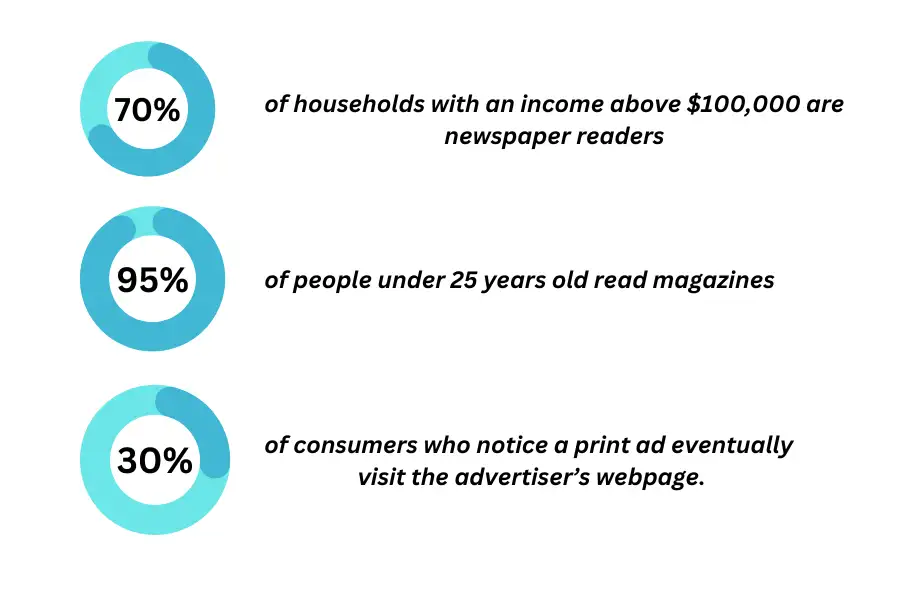
7. Magazines Capture 95% of the Young Audience
Top Media Advertising reveals that an overwhelming 95% of individuals under the age of 25 read magazines regularly. This staggering figure showcases the enduring appeal of print media among the younger generation, debunking the misconception that younger audiences are solely reliant on digital platforms for information and entertainment.
8. Print Ads: The Most Trusted Tool for Purchase Decisions
In a survey by Burstein, an impressive 82% of consumers express their utmost trust in print advertisements when making purchasing decisions. This finding underscores the credibility and influence of print media in shaping consumer choices, offering businesses a reliable and effective avenue to reach their target audience.
9. Print Readers Engage Longer Than Digital Users
Contrary to the brief attention span observed on digital platforms, readers of print publications tend to engage for 20 minutes or more, as noted by Heitman. This discrepancy underscores the deeper connection and undivided focus that print media offers, making it a valuable medium for advertisers to convey their messages effectively.
10. Print Ads: Easier on the Brain, Greater Impact
According to R.C. Brayshaw’s research, print ads require 21% less cognitive effort to process than their digital counterparts. This finding indicates that print advertising has a distinct advantage in capturing attention and leaving a lasting impression on the audience, making it a strategic choice for marketers seeking higher impact and memorability.
11. Print and Digital Combination Yields 400% Greater Effectiveness
By merging print and digital advertising efforts, online campaigns experience a remarkable 400% boost in their overall effectiveness, as reported by Top Media Advertising. This integrated approach leverages the strengths of both mediums, ensuring broader reach and higher engagement rates for businesses.
12. Printed Mail Ads Drive Action in 80% of Consumers
According to Potochny’s study in 2017, nearly 80% of consumers respond actively to direct printed mail advertisements. In contrast, only 45% of consumers take action on electronic advertisements. This demonstrates the enduring influence and impact of print ads on consumer behavior.
13. Print and Direct Mail Marketing: A 9% Customer Response Rate
R.C. Brayshaw’s research in 2020 revealed that print and direct mail marketing campaigns boast an impressive 9% customer response rate. In contrast, other digital marketing channels struggle to achieve a meager 1% or less response rate. This highlights the effectiveness of print in eliciting meaningful interactions.
14. Print Ads Elicit 20% Higher Motivation Response
R.C. Brayshaw’s study in 2020 found that print advertisements generate a notable 20% higher motivation response, particularly when they appeal to multiple senses beyond touch. This multisensory approach heightens engagement and compels audiences to take action, benefiting businesses and brands alike.
15. Print Advertising Trumps Digital in Brand Recall
As reported by Newsworks in 2020, advertising in print yields substantially higher brand recall rates compared to digital channels. With 77% of consumers easily remembering print ads, while only 46% recall digital ads, print proves its efficacy in establishing lasting brand impressions.
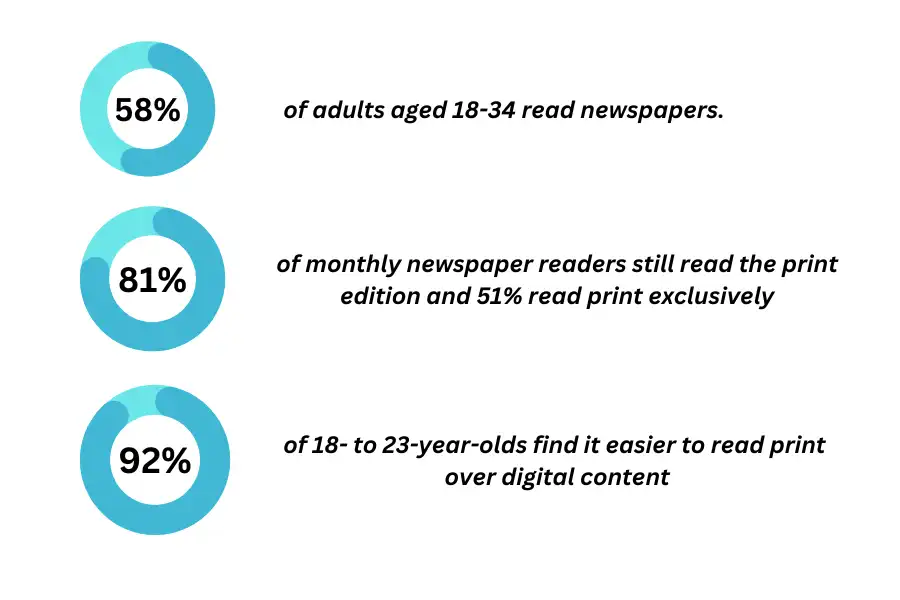
16. Print is Preferred by 92% of Young Adults
According to a study by Forer in 2017, an impressive 92% of individuals aged 18 to 23 prefer reading print content over digital formats. This finding highlights the enduring appeal and readability of print materials among the younger demographic, despite the prevalence of digital media.
17. Direct-Mail Outperforms Email in Response Rate
Medina’s research in 2019 reveals that direct-mail marketing boasts a response rate 37% higher than email marketing. This substantial difference underscores the continued effectiveness of physical mail in capturing recipients’ attention and eliciting responses compared to digital communication.
18. Digital Ads: High Recall, Print Ads: Better Conversions
In a study conducted by Newsworks in 2020, it was found that digital ads have higher recall rates than print ads. However, print ads are more successful (55%) at converting engaged readers into action-takers, compared to digital ads (64%). This indicates the complementary strengths of each medium in an advertising strategy.
19. Print: The Medium for Building Brand Trust
Print media stands out as a more effective platform for building trust in your brand. Its tangible nature and authenticity resonate with consumers, fostering a deeper sense of trust compared to digital counterparts. This finding reaffirms the enduring power of print in establishing strong brand connections.
20. Print Advertisements Drive Web Traffic
Nearly 30% of consumers who notice a print ad end up visiting the advertiser’s webpage. This statistic, backed by data, emphasizes the impact of print advertising in driving online engagement and connecting potential customers to the advertiser’s digital presence.
21. 58% of Adults Aged 18-34 Embrace Newspapers as a Source of Information
According to a study by Marketing Charts in 2017, a significant 58% of adults between the ages of 18 and 34 actively read newspapers. This finding highlights the enduring appeal of print media among the younger generation, despite the rise of digital alternatives.
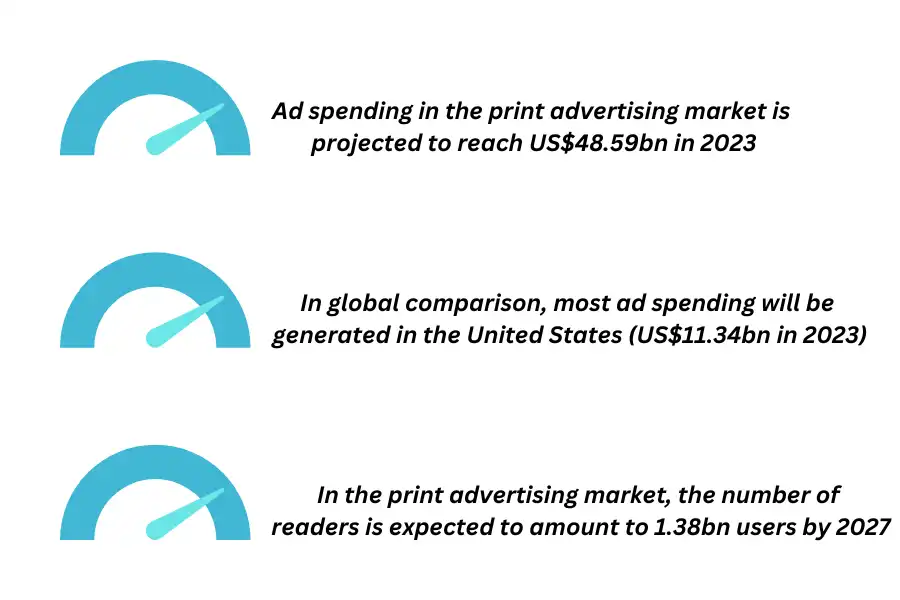
22. 81% of Monthly Newspaper Readers Stay Loyal to Print
Contrary to predictions of declining readership, a remarkable 81% of monthly newspaper readers continue to embrace print editions, as reported by Marketing Charts in 2017. Additionally, over half of them, comprising 51%, exclusively prefer the print format for their news consumption.
23. The Rising Trend of Young Print Readers – 25% Under the Age of 35
As per a study conducted by Perri in 2019, the print newspaper has not lost its appeal to the younger audience. The study found that 25% of print newspaper readers are individuals under the age of 35, consisting of both Millennials and Gen Z, proving that print media still holds relevance for the digitally native generations.
24. Print Advertisements Garner Greater Attention – 49% Increase in 10 Years
Newsworks’ study in 2020 reveals a significant shift in consumer behavior toward print ads. Attention to print advertisements has more than doubled since 2009/10, increasing from 23% to an impressive 49% in 2020. This renewed interest showcases the enduring power of print as an advertising medium.
25. Print News Brands Experience Remarkable 67% Rise in Ad Recall
Newsworks’ comprehensive analysis spanning from 2009/10 to 2019/2020 shows an incredible 67% increase in ad recall for print news brands. This indicates that consumers now better remember and engage with advertisements in print media, making it an attractive platform for marketers to reach their target audiences effectively.
26. Print Ad Emotional Reaction Increases to 37% in 2020
Emotional reaction to print ads has seen a significant boost, reaching 37% in 2020, compared to a mere 22% five years ago. This finding, as reported by Newsworks in 2020, highlights the enduring power of print advertising in evoking strong responses from consumers.
27. Print Ad Viewers Turn into Website Visitors, Surging 27% in 2020
The influence of print advertising extends beyond the page, as consumers who see print ads are now 27% more likely to visit the advertiser’s website. This substantial increase from 12% in 2009, as stated by Newsworks in 2020, illustrates the bridge between print and digital experiences.
28. Print Ad’s Impact on Purchase Intent Soars to 22% in 2020
Print ads have proven their effectiveness in driving purchase intent, experiencing a remarkable rise to 22% in 2020 from a mere 7% in 2009. The data, presented by Newsworks in 2020, reflects the enduring influence of print advertising on consumer behavior.
29. Print Ad Spending Decline Projected: $44,173M to $35,628M (2021-2025)
Print advertising expenditure is expected to witness a decline over the years. Starting at $44,173 million in 2021, the projected figures estimate a gradual decrease to $40,019 million in 2023, and further down to $35,628 million in 2025, as reported by Statista.
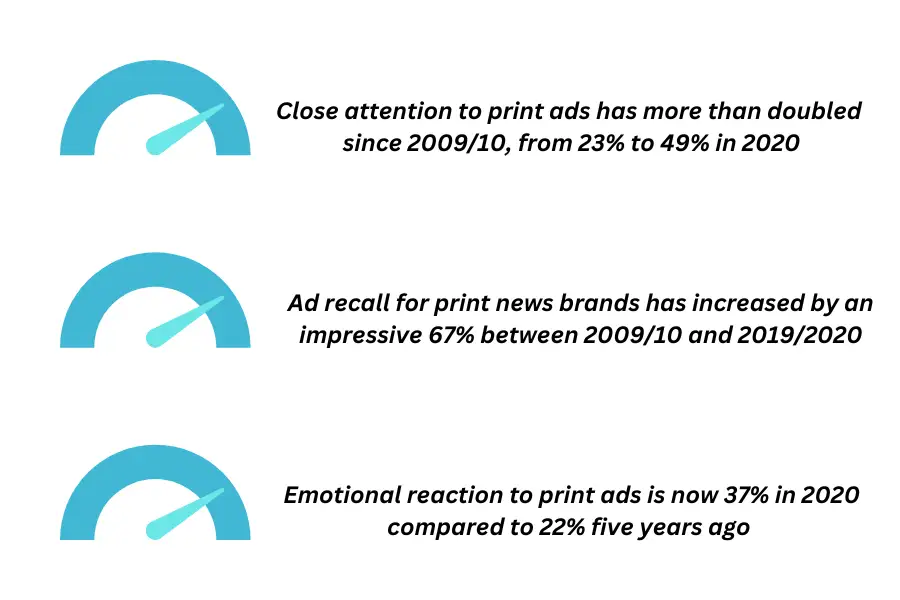
30. Digital Advertising Overtakes Traditional (Print, TV, Radio) in the US
In 2020, digital advertising in the US outstripped traditional advertising, including print, TV, and radio, with a notable lead. Advertisers spent $151.29 billion on digital advertising, while the expenditure on traditional media stood at $107.13 billion, as reported by Wagner in 2019.
Conclusion
Even in this digital era where online advertising dominates, print advertising holds a significant position as an effective means of connecting with target audiences. Its history, dating back to ancient times with inscriptions and posters, has evolved into newspapers, magazines, and billboards, making it a time-tested advertising medium.
The tangible nature of print materials allows for physical engagement, leaving a lasting impact on readers. Moreover, the targeted readership ensures that the messaging reaches the right demographics.
By exploring the 30 unique statistics presented, businesses can make well-informed decisions and harness the potential of print advertising to create compelling campaigns that resonate with consumers. As technology continues to advance, print advertising will likely adapt and complement digital strategies, offering a versatile approach to engaging and reaching customers.
